When Samuel James Blencowe and his wife Mary Parsons bid farewell to their daughter Mary on a ship to Russia, they hoped she would return to England. Instead she married into a wealthy Russian family.
Setting the scene in Russia
Throughout the 1800s the growth of a diverse Russian Empire caused problems for the Romanovs; just as it had for the Hapsburgs of the Austrian Empire. In seeking to maintain control they too had become entrenched in their unyielding rule over a discontented, multinational population. In the 1870s young Russian idealists were planning a new future for their Russia. Although they dressed like peasants and tried to imitate their way of life, all came from middle-class city families and were out of touch with the harsh realities of the Russian peasant life.
Unlike the aristocracy of Western Europe, few Russia landowners had either real landed wealth or blue blood. The nobility acquired their land and their serfs only by service to the ruling tsar. The average landowner and family lived in a modestly furnished one or two storey house with a veranda, summer-house, barn, stables and a granary. The kitchen garden and orchard provided food. The Lodyzhenskiy estates were big comfortable buildings on a grander scale.
I was shocked to see an old 1900s map of Tver region. The estates were situated every 5-10 miles from one another! There were really a lot of them! What a terrible destiny lay ahead! After the revolution almost everything had been either stolen or destroyed. Most of the surrounding territory; fields, forests, peasant villages, churches and landlord estates with beautiful buildings, gardens, swan ponds, irrigation systems etc. were "Gone with the wind".
Only every 10th or 20th estate had been used by the new communes for agriculture or other economic activity.
So where does Mary Blencowe fit in?
A small number of wealthy families spent little time on their estates, arriving in summer to escape the oppressive heat of Moscow or St Petersburg, with a vast retinue of friends, relatives, servants, French tutors and English governesses. They enjoyed the open-air pursuits of hunting, shooting, fishing, picnicking and swimming: an attractive life style for a young English lass from the Isle of Man. Once winter approached, they decamped back to the cities where they enjoyed a brilliant lifestyle or spent time abroad in fashionable spas or gambling away their wealth in the casinos of Europe. It was through such socialising that Mary met her future husband, Ivan Lodyzhenskiy, whom she married in Tver in 1870.
Unfortunately, I know very little about my great-granddad, Ivan and his wife Mary, though my ancestry goes back to the 1600s. My great-great-granddad was brave Colonel Nikolay Vasilyevich Lodyzhenskiy (1803-1863). He married twice and had 8 children from his 1st wife plus 2 more from the second. The Colonel invited an English governess. English was not commonly used in Russia at that time. The aristocracy communicated in French. However, a daughter needed English to be well-bred. In society circles a child needed an English nanny more than a mother. English opened up opportunities for the Colonel’s descendants.
From 1853, the government began to support governesses. It started to give out small pensions, and under the Ministry of Public Education it organized "fund for decrepit and sick people". In 1870, the Moscow Society of Governesses and Teachers was founded, under which there was a recommendation office and a pension fund. Governesses were a common phenomenon in Russia until 1917, when the revolution changed the country and in the new society this profession practically disappeared.
Two of his sons, Nikolay and Ivan, my great-granddad, were very close friends, spending a lot of time together. They started and dropped out of classes in various Universities. Both were fond of music and were excellent pianists. Music has always been the essential part of everyday life in aristocratic families. All young girls played piano, violin or even the harp, most of them sang. In our family all members could play or sing those days. These musical evenings were very common as there was little other entertainment in the evenings, except for cards.
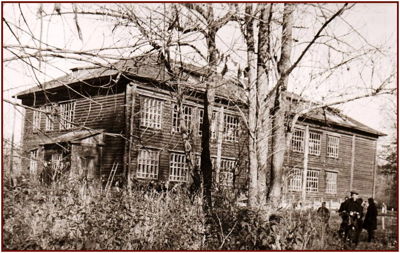
The ruin of Makovnitsy after it was used as a school. Photo 1960
The family was rich, owning a number of large estates in various districts. Among them there were two main and most loved - Makovnitsy, near Kashin city in the Tver district and Adzherovo, near Nizhniy Novgorod. The family usually spent summer in Adzerovo and moved to Makovnitsy in the fall.
In 1860, Colonel Nikolay distributed his assets among his children: specifically stating that, "Makovnitsy should not belong to any one of his children but should stay in common family ownership as the 'ancestral nest'".
The two brothers, Nikolay and Ivan, moved to St. Petersburg and lived the high life: similar to the 1960-70s hippy era.
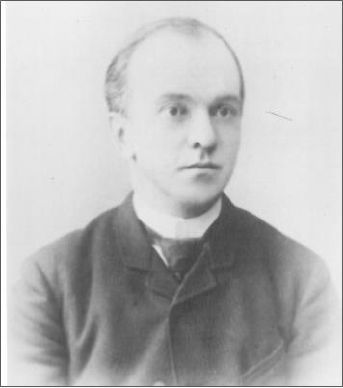
Nikolay
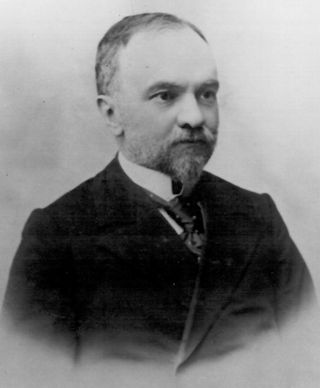
Ivan
They fooled around, trying to study medicine, physics, mathematics and even jurisprudence. They spent money, made friends with music lovers and composers and of course had many girlfriends.
The two brothers made unusual marriages - they, the representatives of Russian ancient nobility, married two "simple" girls. In their marriage records, Mary was a governess, and Alexandra "a worker of Moscow confectionery". Simple implies girls of a lower social class.
Amongst their circle of friends was Moguchaya Kuchka, Russian for The Mighty Handful: formed in 1860, referring to a group of 19th Century Russian composers who wanted to establish a nationalist school of music. They could be described as avant-garde.
M.A. Balakirev was the leader and composed songs, symphonic poems, piano pieces and orchestral music.
N.A. Rimsky-Korsakov, the group’s most prolific composer, wrote operas, symphonies, orchestral works and songs. He conducted military bands, and was director of St. Petersburg's Free Music School from 1874 to 1881
M. P. Mussorgsky: Although he pursued a military career, his passion was in music. He wrote operas, songs, piano pieces and melodies
A. P. Borodin wrote songs, string quartets and symphonies. He was famous for the opera "Prince Igor". It was unfinished when he died in 1887and completed by Rimsky-Korsakov.
C. A. Cui, a staunch supporter of Russian nationalist music, he was a music critic and professor of fortifications at a military academy in St. Petersburg, Russia. Cui is especially known for his songs and piano pieces. This was an impressive group the brothers were mixing with.
The famous Russian composer - Rimskiy-Korsakov, records in his memoirs about one summer he spent with other members of "Moguchaya Kuchka" at Makovnitsy with Ivan and Nikolay. He recalls being an eyewitness to a strange and curious event: "two brothers, sharing one small apartment in St-Petersburg, have been "exchanging their civil wives." The girls weren't named, but were probably Mary and Alexandra - their future "real" wives. It is possible that Mary was the Governess to one of the Moguchaya Kuchka member's family as some had children in the right age bracket.
The "Moguchaya Kuchka" were witnesses at Nikolay's marriage to Alexandra. Nik began his diplomatic career in 1869. He got his first position in the Foreign Ministry then, as a result of the patronage of his friends, members of Moguchaya Kuchka. He was firstly a public servant, interpreter, then the vice-consul, then consul in many European countries. He retired from diplomatic work as Russian Consul General in New-York in 1909. He was a knight of many orders for his diplomatic services.
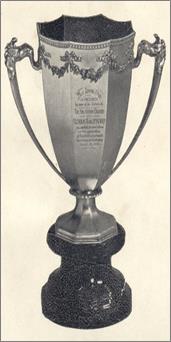
The presentation of a Loving Cup to Mr. Nicholas N. de Lodygensky, the retiring Imperial Consul General of Russia by the Bishop of New York, The Rev. Morgan Dix, D.D. took place, in the Vestry Room of Trinity Chapel, 16 West 26th Street, New York, on 19th March 1908.
After his retirement, he returned to Makovnitsy and took on many social activities in local government. As leader of the nobility, he was an official for special assignments to the Chief Procurator of the Holy Synod, treasurer of the Palestinian Society, and a member of the Slavic Society. He was also the founder of the Society for the Unification of the Orthodox and Anglican Churches. He died in 1916 at his much loved estate, Makovnitsy, where he had spent a lot of time.
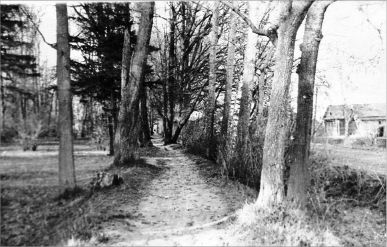
The road into The Makovnitsy Estate Photo 1960
While Nikolay served in diplomatic services, Ivan was busy with a lot of activities. He held various managerial positions, including "General Commissioner of the Russian Department at the International Exhibition in Glasgow", 1901.
Granddad, Ivan and Maria Blenkau married in "Spas na Ildy" church in 1870.
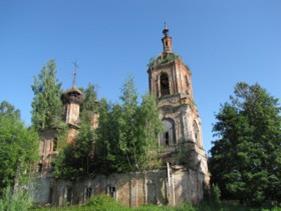
Mary pledged to raise their children in the Russian Orthodox faith, while she herself remained Anglican. In different documents Mary's family name in Russian sounds like Blenko, Blenkau, Blenkowa.
They had 8 children: Sofia, (1871-?), Ivan (1872-1963), Nikolay, my granddad, (1875-1942), Varvara (1877-?), Vera (1887-?), Vladimir (1891-?), Nadezhda (1891-?), Maria (?-?). Ivan died in 1916. When Mary died is unknown.
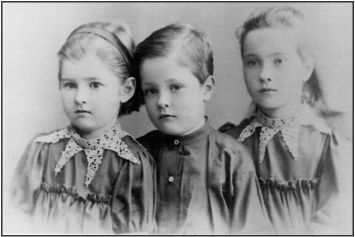
Nadezhda, Valdimir and Varvara
The Russian Revolution from January 1905 to July 1907 saw a wave of mass political and social upheaval that spread through vast areas of the Russian Empire, some of which was directed at the government. It included worker strikes, peasant unrest, and military mutinies. All of Mary’s children except my granddad and his sister Vera left Russia at this time.
Their son, my granddad, Nikolay died of starvation during the 1941-1944 Leningrad siege: a 900 day military blockade undertaken mainly by the German Army Group North against Leningrad (now Saint Petersburg). My Granny with my Mom, stayed in their apartment for most of the siege. They were evacuated to Orenburg a couple of months before the end.
On their return home, they found everything gone: furniture, appliances, documents and the apartment was occupied by another family. Thus, there was nothing left that could tell the story - no pictures, photos, documents –nothing!
I’ve met descendants of Sofia in Paris and in St. Petersburg but communication was hard as I don’t speak French and they can hardly understand Russian and English. However, they have given me the photos used here. Sofia passed the medical courses in Russia and worked as a nurse/partly doctor during WW I.
Vera, a biologist, had been repressed here for a short time and died of cancer in late 1950s. My granny and I visited her a few times. I remember a large aquarium with funny things inside called axolotls.
Vladimir moved to America. His daughter, Ekaterina (1916-2009) was also a doctor, paediatrician, and the head of Russian Pushkin Association in New-York. His son, Nikita and his wife Ekaterina live in France. I met them in St-Petersburg.
We in Russian had almost nothing left after WW II - all went with the apartment. Obviously Granny and Mom did not take any papers with them in evacuation.
This war took my Grandad and made my father, Igor, a cripple. He was the gunner-radio operator in a bomber. He was wounded while preparing the flight plans to counter attack the German planes. He was the only survivor but without his right hand!
It was Granny who mainly brought me up. My Mom was often absent on her business trips. Granny told endless stories about her youth. Unfortunately I was too young to appreciate them. Now I can recall only a few facts and names.
Igor Lodyzhenskiy,
St. Petersburg
Email: igor.lodyzhenskiy @ gmail.com
We don't know when Mary Blencowe went to Russia. The family wasn't in the 1861 Census of England or the Isle of Man. Mary's mother, also a Mary, went to Russia after 1871 as did brother, Frank who was still in Russia in 1900. Perhaps Mary's sisters, Eleanor Harriet Blencowe (1852-?) and Martha Dickens Blencowe (1854-?) went to live there too.
Anyone with access to European shipping or other relevant resources who could look into what became of the siblings of Mary would be of interest to Igor and his family. Anne